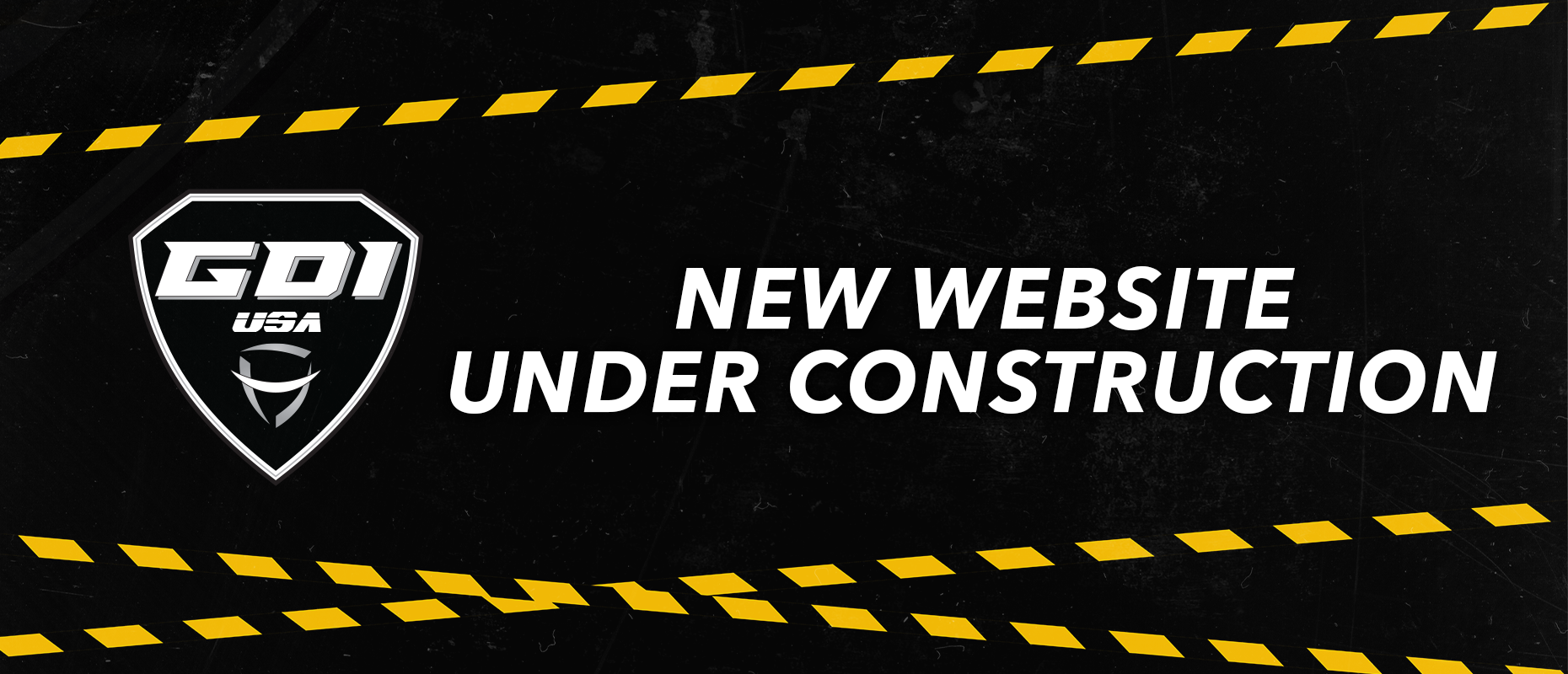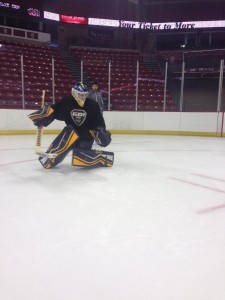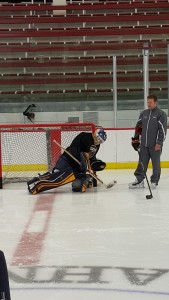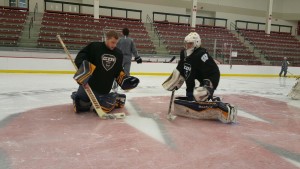For our Newsletter each quarter we will reach out to a different goaltender for the “Quarterly 5 (Q5)”. Asking 5 questions in an effort to examine the unique perspectives they have on their games.
In our 9th installment we talked with Keegan Asmundson, a long time friend, student, and coach of ours. We are proud to announce that Keegan will be playing his first full year of professional hockey in the ECHL. After finishing school at Canisius College last season, he was brought into the Washington Capitals system, spending time with their AHL and ECHL affiliates. The Buffalo Sabres invited him to their September rookie camp. Then the Toronto Maple Leafs required his services with their AHL team, the Marlies. Signed since August with their ECHL affiliate, the Orlando Solarbears, Keegan has since been traded to the Evansville Icemen, the ECHL affiliate of the Ottawa Senators. These teams are all more than intrigued by Keegan’s 6’5” frame and passive style of play. Bread into the GDI philosophy since his Minnesota high school playing days, Keegan has enjoyed success and adversity, as have so many quality goaltenders. Light hearted yet full of fire; let’s now bring you the Q5, with Keegan Asmundson!
Q1: Let’s start with the obvious question; what’s it been like to put yourself on display for 4 NHL teams in a 7 month stretch? We know you have a sarcastic goal of playing in all 30 teams’ organizations.
A: Lots of traveling! It has been a great experience these past 7 months and I have been learning what it takes to be a pro. As an undrafted free agent leaving Canisius I had the opportunity to make my professional debut with the ECHL South Carolina Stingrays last year. Coming from college where I knew everyone for 4 years to being the new guy was a little challenging but fellow GDI USA guy, Jeff Jakitas was there, and I was lucky enough to have him take me under his wing and give me some advice. Thanks again Jacko! From there I went up to the Hershey Bears in the AHL for a month. I also attended Washington’s development camp after the draft. From there I went to Buffalo Sabers rookie camp in September and then spent some time at the NHL training camp. It was great to be back in Buffalo. Next was a quick stop at Toronto Marlies camp, then a quick turnaround, driving 24 hours down to sunny Orlando, Florida. I was recently traded and drove another 13 hours to Evansville, Indiana.
Q2: With each team you have come across a different goalie coach tasked with shaping their club’s puckstoppers emerges. How does a goalie try to play the game that has got them to that point, while staying open minded to what they have to offer?
A: Every goalie coach I have worked with since I turned pro has basically the same teaching principle, simplify the game. Both the goalie and goalie coach have got to the pro ranks for a reason and I have been lucky enough to pick each guy’s brain on various goaltending topics. I had Mitch Korn, Olaf Kolzig, and Scott Murray in Washington and Andrew Allen and Bob Janosz in Buffalo. I’m a big believer in always trying to learn. If it’s one small thing or 30 things, I can take that knowledge and apply it to my game, making myself a better goalie and help the team win more games. The day you stop trying to make your game better is the day you could be without a job. There is not much left to learn when it comes to basic movement like t-pushes and shuffles at the professional level, only daily maintenance.
Q3: You have worked with many of our GDI USA affiliated coaches throughout your career. From your time with the NAHL Austin Bruins, where Elliott Hogue guided you, 3 years spent with Canisius coach John Daigneau to lean on, consulting with current USHL Dubuque Fighting Saints coach Matt Millar each off-season, and even working alongside the staff at this summer’s NDC: GDI WEST. What do you try to take from each opportunity you get to grow and share?
A: All of those coaches have played a huge part in where I am now. I just want to say thank you to all of them for everything. I have always been a late bloomer so working with goalie coaches who understood the position and style that would fit my body size has been a big reason for my strong foundation. The best part about working with those coaches is that they have all been with me through various points in my career. I know my game has evolved over the years and is still developing, but it’s awesome to have the GDI USA coaches that I can always come back to and talk about anything with them.
Q4: With so many of today’s best goalies and most desired prospects judged on size; and with you being one of those massive bodies in front of the net; how do think size relates to the position? Can it be a pro and a con?
A: In today’s game, having size is definitely a pro. At the same time, a big guy who is not athletic is a con. Being a “big guy” goalie has a lot of advantages, but there is also more surface area for pucks to hit. That makes rebound control very important. There are some situations where being a “big guy” goalie is challenging. The net is still 4’ tall and it can be challenging to fit into positions like the VH and RVH. Size is something you can’t teach but you can teach the correct way to use you’re size most effectively. Because I have been able to work with those GDI USA coaches who understand my size and the position I have been able to play and be successful at high levels of hockey. I also have good athleticism which can be a deadly combination. I enjoy watching other “big guy” goalies in the NHL to see how they play certain situations and how they use their body effectively.
Q5: You did not play as much as you would have wanted to through your junior year in college. Yet in your senior season you took the reins and it’s given you the chance to turn professional. How did you manage this and what do you think you learned from it that will resonate with goalies in the same situation?
A: I had to wait my turn in college and make the best of the opportunity I got. Was it easy? No, but anything worth doing is never easy. I was able to manage this situation by focusing on what I can control, Attitude and Effort. I didn’t worry about why the coach is playing him over me. It would have been very easy to be negative and say I got the shaft but I also had to be sure I was still being a good teammate and stay positive through all of the ups and downs. Another thing that also helped me was finding other things to do to take my mind off of hockey. Golf, homework, going on walks, or any other hobby helps keep the mind fresh and focused for the next opportunity you get. I was also lucky enough to be playing Division 1 Lacrosse my first two years at school. Because I was contributing to my lacrosse team, it allowed me to escape from hockey and I was also able to use my “big guy” body to hit everything that moved and lead my team in penalty minutes.
Bonus Q: What is in store for you after your playing days? We know you have a future in coaching and are an excellent goalie coach, but other interests are often kept idle as we commit ourselves to our craft.
A: I have thought a little about what I want to do when my playing days are over. GDI USA coach Brennan Poderzay and I have thought about entering the WWE and going after the Tag-Team Championship! I would really like to still be involved in sports one way or another. I also like the feeling of being on a team and could see myself going in a coaching direction. I really enjoy working with younger goalies and giving back what I have learned over the years. I do know that I do not want a 9-5 desk job. I’d go into farming, construction, or other kind of manual labor job before that.
It’s been an entertaining short story for Keegan recently; we hope it translates into a long and prosperous read from here. Thanks for sharing and laughing, and best of luck Keegs!! Follow Keegan Asmundson @keegs33 on twitter.





